英语面试说课稿
- 格式:doc
- 大小:32.00 KB
- 文档页数:2
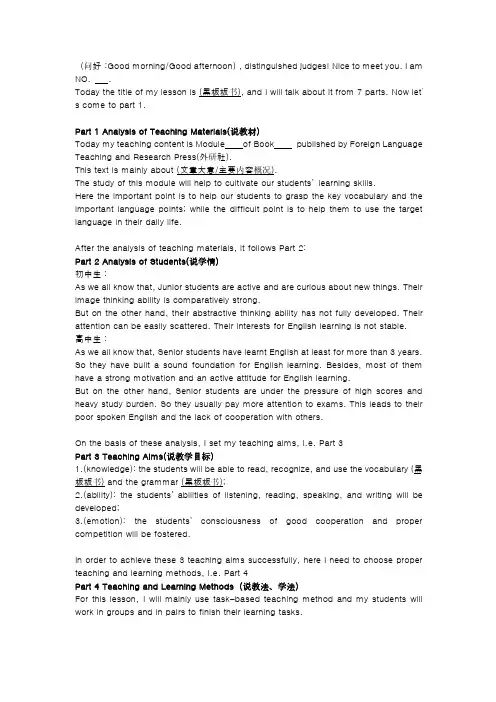
(问好:Good morning/Good afternoon),distinguished judges!Nice to meet you.I am NO..Today the title of my lesson is(黑板板书),and I will talk about it from7parts.Now let’s come to part1.Part1Analysis of Teaching Materials(说教材)Today my teaching content is Module of Book published by Foreign Language Teaching and Research Press(外研社).This text is mainly about(文章大意/主要内容概况).The study of this module will help to cultivate our students’learning skills.Here the important point is to help our students to grasp the key vocabulary and the important language points;while the difficult point is to help them to use the target language in their daily life.After the analysis of teaching materials,it follows Part2:Part2Analysis of Students(说学情)初中生:As we all know that,Junior students are active and are curious about new things.Their image thinking ability is comparatively strong.But on the other hand,their abstractive thinking ability has not fully developed.Their attention can be easily scattered.Their interests for English learning is not stable.高中生:As we all know that,Senior students have learnt English at least for more than3years. So they have built a sound foundation for English learning.Besides,most of them have a strong motivation and an active attitude for English learning.But on the other hand,Senior students are under the pressure of high scores and heavy study burden.So they usually pay more attention to exams.This leads to their poor spoken English and the lack of cooperation with others.On the basis of these analysis,I set my teaching aims,i.e.Part3Part3Teaching Aims(说教学目标)1.(knowledge):the students will be able to read,recognize,and use the vocabulary(黑板板书)and the grammar(黑板板书);2.(ability):the students’abilities of listening,reading,speaking,and writing will be developed;3.(emotion):the students’consciousness of good cooperation and proper competition will be fostered.In order to achieve these3teaching aims successfully,here I need to choose proper teaching and learning methods,i.e.Part4Part4Teaching and Learning Methods(说教法、学法)For this lesson,I will mainly use task-based teaching method and my students will work in groups and in pairs to finish their learning tasks.OK so much about my teaching and learning methods,next comes to the most important part.Part5Teaching Procedure(说教学过程)I will talk about it from5steps.But before that I will first divide my whole class into4 groups.Now let’s come to Step1Step1Warm-up and Lead-inHere I will show several pictures related to the new lesson on the screen and give the students5munites to have a free talk bu using the words they have learnt before. Purpose:☻Pictures can easily stimulate the students’interests;☻This is a more interesting way than the traditional dictation to review the vocabulary;☻Free talk can make the students relaxed without worrying too much about making mistakes publicly.This harmonious atmosphere is good for our students to express themselves bravely.Step2Pre-readingI will ask3questions about the topic of the new lesson,then invite the students to discuss in their group to guess the main idea and content of the new lesson and encourage them to share their ideas with the whole class.At last I will make assessments on each group.Purpose:☻Cultivate our students’abilities of observation,guessing and reason;☻This is an invisible way to check whether our students have previewed the text before the class.Step3While-readingBefore while-reading,I will first explain the grammar(具体名字)in details.Here I mainly design3activities:1.The students listen to the tape and read after it for twice,and after that I will explain the key vocabulary and the important language points in details;2.Invite the students to do role-reading.One group reads one paragraph,and that group is responsible for finding out the topic sentence and summarizing the main idea of that paragraph.Then every group reports their work to the whole class.I will evaluate their answers and communicate with them about their new ideas;3.I will give the students5munites to do the following practice in(具体课本中的位置) on the Book.And I will first call some students to answer these questions,then I will check the answers with the whole class.Here the students who gave wrong answers will be punished to sing a song.Purpose:☻Practice the students’abilities of listening,speaking and reading;☻Help the students to grasp the key vocabulary and the important language points;☻Sing publicly can help the students to overcome their shyness which is a common obstacle among Chinese students when learning a foreign language;☻We all know that in the middle of a class our students tend to get tired.So here singing can make them energetic and concentrated for the rest of the class;☻Punishment will make the students nervous;while singing will make them relaxed.So a good balance between tense and relax will be good for students to remember what that have learnt in the class.Step4Post-readingHere I design2activities:1.Ask some students to summarize what you have learnt in this class,and I will evaluate their summaries;2.Give the students5munites to get prepared to retell the text in their own words. Purpose:☻Summarizing and retelling are both reflexible and comprehensive ways to check whether our students have grasped what they learnt in this class and how much they have grasped;☻For any language learning,output is the final goal.Through retelling,the students’ability of outputting will be trained and developed;☻During that5munites’preparation,the students’logical thinking ability can be developed.Step5Homework1.Writing(每个module的Task);2.Preview the new text.Purpose:☻Writing will deepen our students’understanding for the new lesson and prevision will get the students prepared for the new lesson.Part6Blackboard Design(说板书设计)Finally I will talk about my blackboard design.I will separate the blackboard into3 parts.The left part is for new words and phrases.The middle part is for the grammar. And the right part is for the important language points.OK,so much for my presentation.Thank you very much for your attention.。
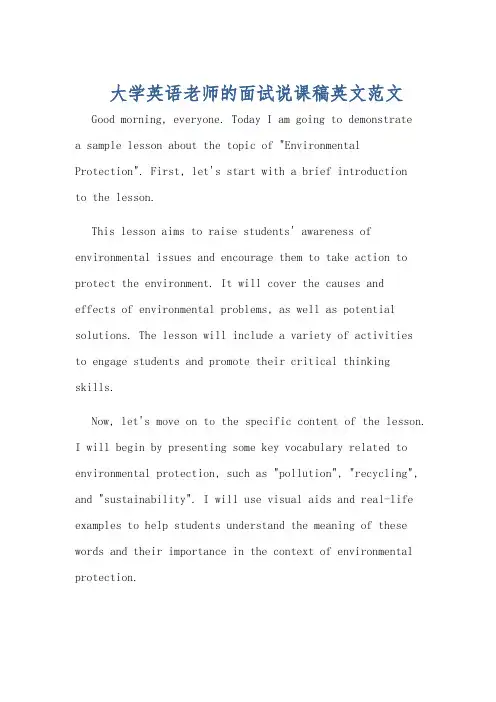
大学英语老师的面试说课稿英文范文Good morning, everyone. Today I am going to demonstratea sample lesson about the topic of "Environmental Protection". First, let's start with a brief introductionto the lesson.This lesson aims to raise students' awareness of environmental issues and encourage them to take action to protect the environment. It will cover the causes andeffects of environmental problems, as well as potential solutions. The lesson will include a variety of activitiesto engage students and promote their critical thinking skills.Now, let's move on to the specific content of the lesson.I will begin by presenting some key vocabulary related to environmental protection, such as "pollution", "recycling", and "sustainability". I will use visual aids and real-life examples to help students understand the meaning of these words and their importance in the context of environmental protection.Next, I will introduce some environmental problems that are currently affecting our planet, such as air and water pollution, deforestation, and climate change. I will discuss the causes and effects of these issues, as well as their impact on both humans and wildlife. I will also emphasize the urgency of addressing these problems and the potential consequences if we do not take action.After that, I will present some potential solutions to these environmental problems, such as reducing carbon emissions, conserving natural resources, and promoting renewable energy sources. I will encourage students to think critically about these solutions and consider how they can contribute to environmental protection in their daily lives.To reinforce the lesson content, I will engage students in a variety of activities, such as group discussions,role-plays, and multimedia presentations. These activities will encourage students to express their opinions, collaborate with their peers, and develop their communication skills.Finally, I will conclude the lesson by summarizing the key points and encouraging students to reflect on what they have learned. I will also assign them a follow-up task,such as writing a short essay or creating a poster on the topic of environmental protection.In conclusion, this lesson is designed to educate students about the importance of environmental protection and inspire them to take action to preserve our planet. I believe that by providing engaging and interactive activities, I can effectively convey the message and stimulate students' interest in this critical issue.Thank you for your attention. Now, I will switch to Chinese to summarize the main points of the lesson.大家早上好。
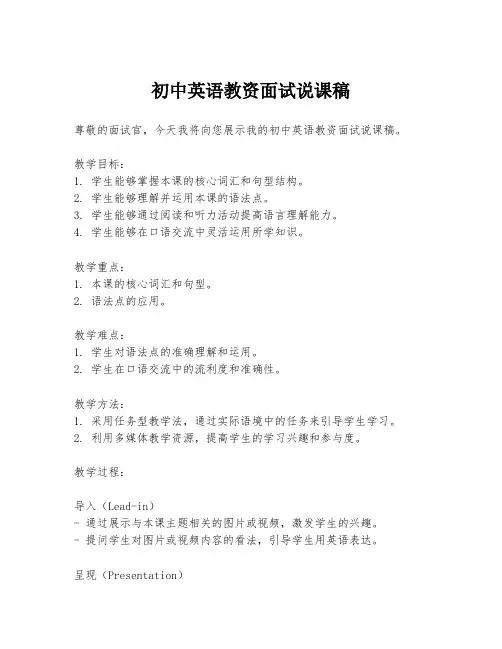
初中英语教资面试说课稿尊敬的面试官,今天我将向您展示我的初中英语教资面试说课稿。
教学目标:1. 学生能够掌握本课的核心词汇和句型结构。
2. 学生能够理解并运用本课的语法点。
3. 学生能够通过阅读和听力活动提高语言理解能力。
4. 学生能够在口语交流中灵活运用所学知识。
教学重点:1. 本课的核心词汇和句型。
2. 语法点的应用。
教学难点:1. 学生对语法点的准确理解和运用。
2. 学生在口语交流中的流利度和准确性。
教学方法:1. 采用任务型教学法,通过实际语境中的任务来引导学生学习。
2. 利用多媒体教学资源,提高学生的学习兴趣和参与度。
教学过程:导入(Lead-in)- 通过展示与本课主题相关的图片或视频,激发学生的兴趣。
- 提问学生对图片或视频内容的看法,引导学生用英语表达。
呈现(Presentation)- 介绍本课的核心词汇和句型,通过例句来展示它们的用法。
- 通过PPT展示语法点,并解释其规则和用法。
练习(Practice)- 分组让学生进行角色扮演,使用新学的词汇和句型进行对话。
- 进行语法点的专项练习,如填空、改错等。
应用(Application)- 组织学生进行小组讨论,讨论与本课主题相关的实际问题。
- 让学生用英语写一篇短文,运用所学的词汇和语法点。
总结(Summary)- 回顾本课的重点和难点,确保学生能够准确掌握。
- 鼓励学生在课后继续练习和复习。
作业(Homework)- 布置相关的阅读材料,要求学生在阅读后回答相关问题。
- 让学生准备一个与本课主题相关的简短演讲。
教学反思(Reflection)- 课后,我会反思教学过程中的得失,考虑如何改进教学方法和策略,以更好地满足学生的学习需求。
通过本课的教学,我希望能够激发学生学习英语的兴趣,同时帮助他们建立起扎实的语言基础。
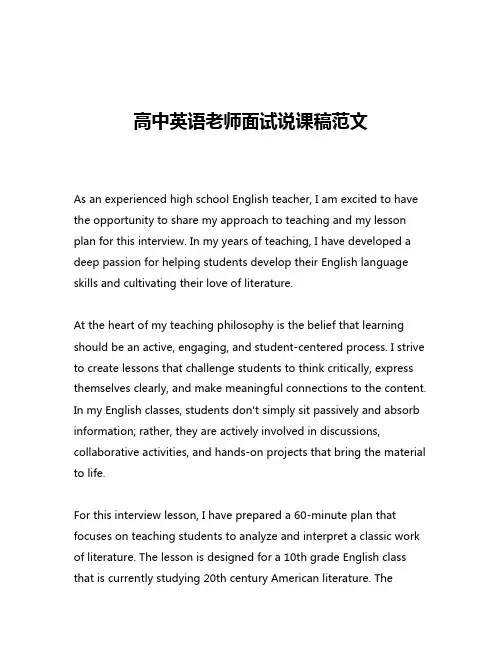
高中英语老师面试说课稿范文As an experienced high school English teacher, I am excited to have the opportunity to share my approach to teaching and my lesson plan for this interview. In my years of teaching, I have developed a deep passion for helping students develop their English language skills and cultivating their love of literature.At the heart of my teaching philosophy is the belief that learning should be an active, engaging, and student-centered process. I strive to create lessons that challenge students to think critically, express themselves clearly, and make meaningful connections to the content. In my English classes, students don't simply sit passively and absorb information; rather, they are actively involved in discussions, collaborative activities, and hands-on projects that bring the material to life.For this interview lesson, I have prepared a 60-minute plan that focuses on teaching students to analyze and interpret a classic work of literature. The lesson is designed for a 10th grade English class that is currently studying 20th century American literature. Theprimary text we will examine is "The Great Gatsby" by F Scott Fitzgerald.I will begin the lesson by engaging students with a thought-provoking question that connects to the themes and ideas explored in the novel. I might ask something like "What does it mean to achieve the American Dream, and how does Gatsby's pursuit of this dream shape the events of the story?" This question will encourage students to draw on their prior knowledge of the novel and begin to think critically about its key themes.Next, I will provide students with a brief overview of the historical and cultural context of "The Great Gatsby." I will discuss the post-World War I era in which the novel is set, highlighting the dramatic social and economic changes that were taking place in American society at the time. I will also touch on Fitzgerald's own life and experiences, as these often served as inspiration for his writing.With this foundation laid, I will then guide students through a close reading of a pivotal passage from the novel. I will carefully select a passage that exemplifies Fitzgerald's masterful use of language and symbolism, as well as one that illuminates important character development or thematic elements. As we read through the passage together, I will pause at key moments to ask probing questions that encourage students to analyze the author's word choice, narrativetechniques, and underlying messages.For example, I might focus on a passage that describes one of Gatsby's lavish parties, and ask students to consider how the details Fitzgerald includes reflect the excesses and illusions of the Jazz Age. Or I might examine a scene that depicts the stark contrast between Gatsby's ostentatious mansion and the bleak "valley of ashes" where George and Myrtle Wilson live, and have students discuss how this contrast serves to critique the emptiness of the American Dream.Throughout this close reading, I will be sure to model effective annotation strategies, such as underlining key phrases, circling important symbols, and jotting down questions or observations in the margins. I will encourage students to actively engage with the text and follow along, annotating the passage as we proceed.After the close reading, I will transition to a small-group activity that allows students to delve deeper into the novel's themes and their own interpretations. I might have students work in pairs or triads to analyze a different passage from the text, using the same close reading strategies we practiced as a class. Each group will then share their findings with the larger group, sparking a lively discussion.To wrap up the lesson, I will bring students back together for a final reflection. I might ask them to consider how the passage weexamined today connects to the novel as a whole, or to share one key insight they gained about Fitzgerald's artistic vision and its relevance to their own lives. This will reinforce the enduring significance of "The Great Gatsby" and encourage students to continue exploring its themes and complexities.Throughout the lesson, I will employ a variety of instructional strategies to maintain student engagement and accommodate different learning styles. In addition to the whole-class discussions and small-group activities, I may incorporate multimedia elements such as audio recordings of Fitzgerald reading excerpts from the novel, or visual aids that illustrate the lavish world of 1920s Long Island. I will also be sure to differentiate my questioning and provide ample opportunities for students to share their ideas and receive feedback.Ultimately, my goal for this lesson is to inspire students to develop a deep appreciation for "The Great Gatsby" and the art of literary analysis. By guiding them through a close reading of the text, facilitating engaging discussions, and encouraging them to make personal connections to the material, I hope to ignite their curiosity and deepen their understanding of this enduring American classic. Through this process, students will not only hone their critical thinking and communication skills, but also gain valuable insights into the human condition and the pursuit of the American Dream.Thank you for the opportunity to present my approach to teaching English literature. I am confident that my passion for the subject, my commitment to student-centered learning, and my ability to craft dynamic, engaging lessons will make me a valuable addition to your teaching staff. I welcome any questions you may have, and I look forward to further discussing my qualifications and teaching philosophy.。
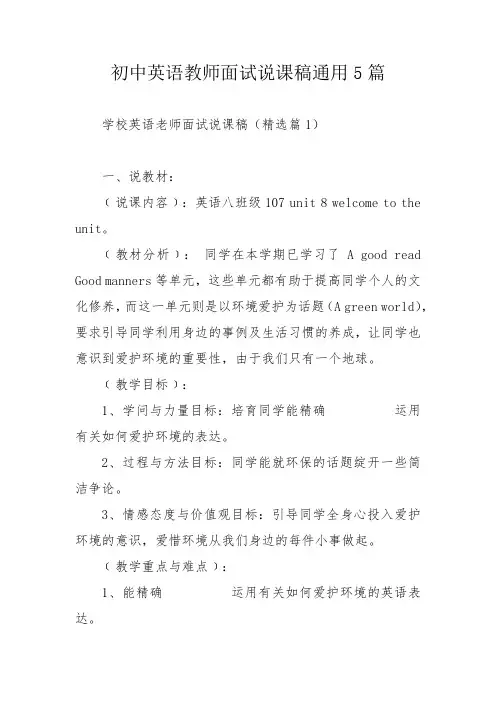
初中英语教师面试说课稿通用5篇学校英语老师面试说课稿(精选篇1)一、说教材:﹝说课内容﹞:英语八班级107 unit 8 welcome to the unit。
﹝教材分析﹞:同学在本学期已学习了 A good read Good manners等单元,这些单元都有助于提高同学个人的文化修养,而这一单元则是以环境爱护为话题(A green world),要求引导同学利用身边的事例及生活习惯的养成,让同学也意识到爱护环境的重要性,由于我们只有一个地球。
﹝教学目标﹞:1、学问与力量目标:培育同学能精确运用有关如何爱护环境的表达。
2、过程与方法目标:同学能就环保的话题绽开一些简洁争论。
3、情感态度与价值观目标:引导同学全身心投入爱护环境的意识,爱惜环境从我们身边的每件小事做起。
﹝教学重点与难点﹞:1、能精确运用有关如何爱护环境的英语表达。
2、培育同学爱护环境的.意识。
﹝教学预备﹞:1、老师预备:搜集目前环境恶化的一些典型实例、图片,用数据表明我们的地球已陷入危急境地了。
2、同学预备:从日常生活中找了找出爱护环境的一些做法,如,那些是不文明的做法,如何低碳生活等。
二、说教法与学法特色:抓住Hobby与 Eddie卡通人物的对话这个主题,创设情境,以情导航。
引导全班同学乐观参加这个对话,从面引出How to protect Environment、在学法指导上,我实行是迁移、点拨、反馈等多各种指导方法。
三、说教学程序设计:依据以上教学理念,结合本课的特点,我设计如下的几个教学环节:一、情景导入,激发情趣。
二、合作探究,提高力量。
三、课堂总结,课后延长。
四、说板书设计;它是结合本课的重点,难点,所勾画出一张图表,体现了美观、有用。
也是师生活动的主要内容。
五、说预期效果(激情结语):各位专家,各位老师:爱护环境刻不容缓,由于我们人类只有一个地球,目前环境的恶化已许多人很担忧,她是我们人类赖以生存的的地方,通过本课的学习,能唤起我们更多的人对爱护环境的意识,而爱护环境的重要性也让我们的孩子从身边的小事做起,让他们糊涂地意识到这一重要性。
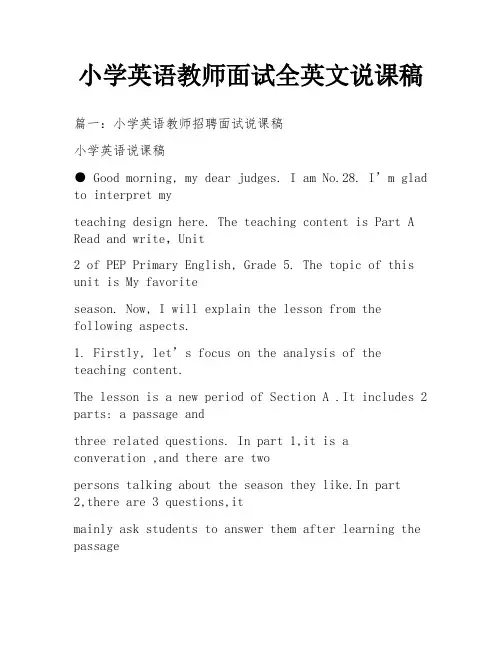
小学英语教师面试全英文说课稿篇一:小学英语教师招聘面试说课稿小学英语说课稿● Good morning, my dear judges. I am No.28. I’m glad to interpret myteaching design here. The teaching content is Part A Read and write,Unit2 of PEP Primary English, Grade 5. The topic of this unit is My favoriteseason. Now, I will explain the lesson from the following aspects.1. Firstly, let’s focus on the analysis of the teaching content.The lesson is a new period of Section A .It includes 2 parts: a passage andthree related questions. In part 1,it is aconveration ,and there are twopersons talking about the season they like.In part2,there are 3 questions,itmainly ask students to answer them after learning the passagecarefully,and it can help the students review the knowledge of this lesson.2. Secondly, it is about the students.Our students are in Grade 5. They are active, curious, and interested innew things. And they have already mastered some basic Englishbackground knowledge after learning English for several years. So theteacher should attach importance to the munication with them,providing them the chances of using languages.3.Thirdly, I set the following aims.By the end of the lesson, students will be able to read, recognize, and usethese words:And, these sentences:By the end of the lesson,Ss can understand the passage and get useful information from thepassage through attentive listening and reading.Ss can use the target language to make a new conversation according tothe passage.In this lesson, the emotional aims are:to foster Ss’ consciousness of good-cooperation and properpetitionto help Ss cultivate their abilities to analyze and solve problemsindependently.to make sure that Ss can use the target languages correctly and skillfully.to develop Ss’ interests in English.The difficult points are:The pronunciation of the new words and the use of the new sentences4.Fourthly, it talks about teaching methods.In this lesson, I will mainly use “Task-based teaching method”, “Communicative language teaching method” ,“TPR teaching method”, and so on.5.Fifthly, let’s focus on the teaching procedures.I will finish the lesson in five steps.It will cost about 5 mins.After greeting with the Ss, I will begin the lesson by singing the song together with the Ss in order to help them form a betterEnglish learning surrounding ,and it providessituations to review the learnt knowledge forthe next step at the same time.It will cost about 15 mins. Firstly, after teachingthe students the new words, I will encourage them to read the words by petition.We will praise the one who reads the fastest and the most accurate. Of course , I will never forget impart the knowledge ofpronunciation rules in teaching the new words. And then, turn to page 18,let’s focus on the passage. And I will ask them to underline the key sentences of the passage at the same time. After learning the passage , I will let them read after me in order to make them read it fluently. And I check them to read it in pairs. And then, let them answer the following questions of thepassage.It will cost 10 mins, due to the Ss’ age, I set a situation of the seasons by showing some pictures on the blackboard to let the students describe. I ask them to focus on the passage again to draw the whole Ss’ attention to the understanding of the passage,and let them to find the desciption words about the seasons as quickly as possible. And then, I encouragethem to put up their hands to write their answers on the blackboard. It will cost 7 mins. In this step, I will give Ss a free space to show their abilities.I will show the pictures again, and then let them discuss the topic in groups ,and encourage some groups to show their ideas in front of the class.The activity is to develop Ss’ abilities of munication, and also, their abilities of cooperation will be well developed. Making a new dialogue is to check if Ss can use the target languages correctly andskillfully. It will cost about 3 mins. In this step, I will guide the Ss to conclude what they learnt today and then , place the homework.6.Now, this is my blackboard design.That’s all for my teaching design. Thank you a lotfor listening. (GONG)篇二:小学英语教师招聘说课稿(全英文万能版)小学英语教师招聘说课稿(英文万能版)● Good morning, my dear judges. I am number_______. I’m glad tointerpret my teaching design here.● My teaching content today is Partof Unit of PEPPrimary English, Book This unit is mainly about Now, I will explain the lesson from the following aspects.1. 教学内容 (Contents)Firstly, let’s focus on the analysis of teaching content.The lesson is a new one of Unit .It includes , ____ and . In section 1, itmainly deals with these key words,2. 教学对象(talk about the students)Secondly, it is about the students.Our students are in GradeThey are active and curious, interested in new things.After learning English for years, they have some basic Englishbackground knowledge, so the teacher should attach importance to themunication with them, providing them the chances of using language.They have learnt English for years, and have already knownIt is not difficult for them to understand and use the language3. 教学目标 (Teaching aims)So, I set the following aims.By the end of the lesson, students will be able to read, recognize, and usethese words:And, these sentences:By the end of the lesson,①Ss can understand the and get useful information from the throughattentive listening / reading.②Ss are able to talk about③Ss can use to give suggestions on④Ss’ abilities of listening and speaking will be developed.(Affect;Learning strategies;cultural awareness.)In this lesson, the emotional aim is①to help students cultivate and foster theirabilities of working ingroups.②to foster Ss’ consciousness of good-cooperation and properpetition.③to help Ss cultivate their abilities to analyze and solve problemsindependently.④to foster Ss’ initiative and creativeness.⑤to help Ss to recognize and identify the differences between Chineseand English cultures on ⑥to help Ss know some and prehend the①to make sure that Ss can use Correctly andskillfully.to develop Ss’ inter est in English.②The difficult point is:The pronunciation of 4.教法学法(Teaching methods)Fourthly, it talks about teaching methods.In this lesson, I will mainly use “Task-based teaching method”,“Communicative language teaching method” and “TPR teaching met hod”,and so on.4. 教学过程① 具体steps 根据具体内容定;一般分为:warming up \ leadin\presentation\consolidation\homework②板书steps + purpose 说明;③如有可能,同时完成layout设计;Next, let’s focus on the teaching procedures.I will finish the lesson in steps.It will cost about mins.After greeting with the Ss, I will begin the lesson by singing the song together with the Ss.Purpose:The purpose of this is to form a better English learning surrounding forthe Ss, and, at the same time, it provides situations to review the learntknowledgefor the next step.It will cost about mins.With the help of the PPT, I set a situation of by to stimulate the Ss’ interest of the lesson.By playing the PPT, IAnd then, (板书layout)The purpose of this is to present the new words and sentences in thes ituation, which relates to the Ss’ real life experiences, to help the Ssunderstand the language easily and naturally.After presenting each new word (by the guessing game), I will impart theknowledge of pronunciation rules in teaching the new words.It is called Phonics.It can facilitate the Ss’ abilities to pronounce the words, and help them toremember the spelling of the words.(机械上口;有意义操练;let’s do;课文对话表演;)篇三:中学英语教师招聘面试全英文说课稿Good morning, everyone !I’m No.____ candidate. Nice to meet you! (鞠躬)Today my topic is about ________________________,(板书) I will analyze the lesson from the six parts.:analysis of teachingmaterial, teaching aims and demands, student analysis, teaching methods, learning methods and procedures. (下面我将从教材、教学目标和要求、学情、教法、学法、教学程序等几个方面进行说课。
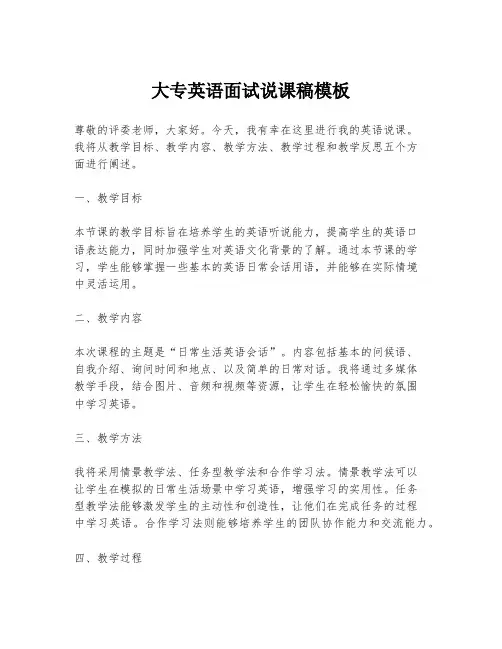
大专英语面试说课稿模板尊敬的评委老师,大家好。
今天,我有幸在这里进行我的英语说课。
我将从教学目标、教学内容、教学方法、教学过程和教学反思五个方面进行阐述。
一、教学目标本节课的教学目标旨在培养学生的英语听说能力,提高学生的英语口语表达能力,同时加强学生对英语文化背景的了解。
通过本节课的学习,学生能够掌握一些基本的英语日常会话用语,并能够在实际情境中灵活运用。
二、教学内容本次课程的主题是“日常生活英语会话”。
内容包括基本的问候语、自我介绍、询问时间和地点、以及简单的日常对话。
我将通过多媒体教学手段,结合图片、音频和视频等资源,让学生在轻松愉快的氛围中学习英语。
三、教学方法我将采用情景教学法、任务型教学法和合作学习法。
情景教学法可以让学生在模拟的日常生活场景中学习英语,增强学习的实用性。
任务型教学法能够激发学生的主动性和创造性,让他们在完成任务的过程中学习英语。
合作学习法则能够培养学生的团队协作能力和交流能力。
四、教学过程1. 导入(Lead-in):通过播放一段英语日常对话的视频,引起学生的兴趣,同时为接下来的学习内容做铺垫。
2. 呈现(Presentation):展示一些基本的英语会话用语,并通过图片和例句帮助学生理解。
3. 操练(Practice):学生分组进行角色扮演,模拟不同的日常对话场景,加深对会话用语的理解和记忆。
4. 应用(Application):设计一些实际的对话任务,让学生在真实或模拟的情境中使用所学的语言。
5. 总结(Summary):回顾本节课的重点内容,强调语言的实际应用。
五、教学反思在教学结束后,我会收集学生的反馈,评估教学效果,思考教学中存在的问题和不足,并在今后的教学中不断改进和优化。
最后,我相信通过本节课的学习,学生们不仅能够提高英语口语能力,还能增进对不同文化的理解,为将来的学习和生活打下坚实的基础。
谢谢大家的聆听。
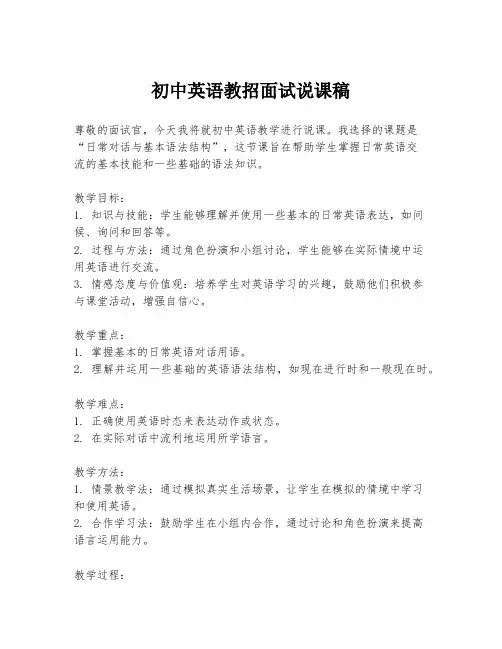
初中英语教招面试说课稿尊敬的面试官,今天我将就初中英语教学进行说课。
我选择的课题是“日常对话与基本语法结构”,这节课旨在帮助学生掌握日常英语交流的基本技能和一些基础的语法知识。
教学目标:1. 知识与技能:学生能够理解并使用一些基本的日常英语表达,如问候、询问和回答等。
2. 过程与方法:通过角色扮演和小组讨论,学生能够在实际情境中运用英语进行交流。
3. 情感态度与价值观:培养学生对英语学习的兴趣,鼓励他们积极参与课堂活动,增强自信心。
教学重点:1. 掌握基本的日常英语对话用语。
2. 理解并运用一些基础的英语语法结构,如现在进行时和一般现在时。
教学难点:1. 正确使用英语时态来表达动作或状态。
2. 在实际对话中流利地运用所学语言。
教学方法:1. 情景教学法:通过模拟真实生活场景,让学生在模拟的情境中学习和使用英语。
2. 合作学习法:鼓励学生在小组内合作,通过讨论和角色扮演来提高语言运用能力。
教学过程:1. 导入(5分钟):通过播放一段英语日常对话的视频,激发学生的兴趣,引入本课主题。
2. 新课呈现(15分钟):介绍基本的问候语、询问和回答的表达方式,以及现在进行时和一般现在时的语法结构。
3. 操练(15分钟):学生分组进行角色扮演,模拟购物、问路等日常场景,练习使用所学语言。
4. 应用(10分钟):设计一个“英语角”活动,让学生自由交流,教师巡视指导。
5. 总结(5分钟):回顾本课所学内容,强调语言的实用性和语法的正确性。
作业布置:1. 完成一份关于日常对话的练习题。
2. 准备一个简短的英语自我介绍,下节课进行展示。
教学反思:课后,我将根据学生的反馈和表现,反思教学方法和内容的适宜性,不断调整和优化教学策略,以满足不同学生的学习需求。
通过这节课,学生不仅能够学习到实用的英语对话技巧,还能够在轻松愉快的氛围中提高英语语言能力。
我相信,通过持续的练习和应用,学生们的英语水平将得到显著提升。
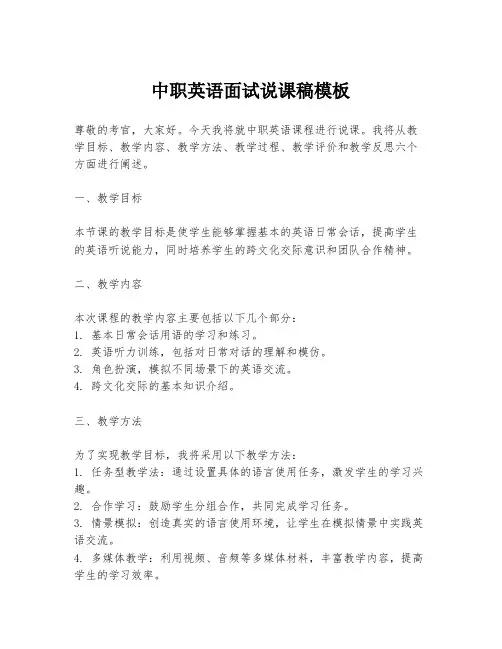
中职英语面试说课稿模板尊敬的考官,大家好。
今天我将就中职英语课程进行说课。
我将从教学目标、教学内容、教学方法、教学过程、教学评价和教学反思六个方面进行阐述。
一、教学目标本节课的教学目标是使学生能够掌握基本的英语日常会话,提高学生的英语听说能力,同时培养学生的跨文化交际意识和团队合作精神。
二、教学内容本次课程的教学内容主要包括以下几个部分:1. 基本日常会话用语的学习和练习。
2. 英语听力训练,包括对日常对话的理解和模仿。
3. 角色扮演,模拟不同场景下的英语交流。
4. 跨文化交际的基本知识介绍。
三、教学方法为了实现教学目标,我将采用以下教学方法:1. 任务型教学法:通过设置具体的语言使用任务,激发学生的学习兴趣。
2. 合作学习:鼓励学生分组合作,共同完成学习任务。
3. 情景模拟:创造真实的语言使用环境,让学生在模拟情景中实践英语交流。
4. 多媒体教学:利用视频、音频等多媒体材料,丰富教学内容,提高学生的学习效率。
四、教学过程1. 导入(5分钟):通过一段简短的英语日常对话视频,引起学生对本节课内容的兴趣。
2. 新课呈现(15分钟):介绍并教授基本的日常会话用语,通过PPT展示和板书辅助。
3. 听力训练(10分钟):播放英语对话录音,让学生练习听力理解并模仿发音。
4. 角色扮演(15分钟):学生分组进行角色扮演,模拟不同场景的英语对话。
5. 跨文化交际知识讲解(10分钟):介绍不同文化背景下的交际习惯和礼仪。
6. 总结反馈(5分钟):总结本节课的学习要点,鼓励学生进行自我反思和评价。
五、教学评价本节课的教学评价将采用形成性评价和总结性评价相结合的方式。
形成性评价主要通过课堂观察、小组讨论和角色扮演的表现来进行;总结性评价则通过课后的英语会话练习和听力测试来完成。
六、教学反思在课后,我将根据学生的反馈和课堂表现进行教学反思,调整教学策略,以更好地满足学生的学习需求。
最后,我相信通过本节课的学习,学生们能够在轻松愉快的氛围中提高自己的英语交际能力,并增强跨文化交流的意识。
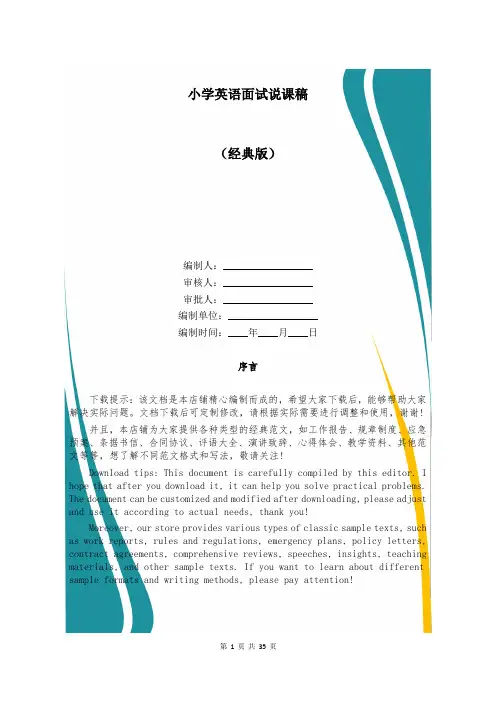
小学英语面试说课稿(经典版)编制人:__________________审核人:__________________审批人:__________________编制单位:__________________编制时间:____年____月____日序言下载提示:该文档是本店铺精心编制而成的,希望大家下载后,能够帮助大家解决实际问题。
文档下载后可定制修改,请根据实际需要进行调整和使用,谢谢!并且,本店铺为大家提供各种类型的经典范文,如工作报告、规章制度、应急预案、条据书信、合同协议、评语大全、演讲致辞、心得体会、教学资料、其他范文等等,想了解不同范文格式和写法,敬请关注!Download tips: This document is carefully compiled by this editor. I hope that after you download it, it can help you solve practical problems. The document can be customized and modified after downloading, please adjust and use it according to actual needs, thank you!Moreover, our store provides various types of classic sample texts, such as work reports, rules and regulations, emergency plans, policy letters, contract agreements, comprehensive reviews, speeches, insights, teaching materials, and other sample texts. If you want to learn about different sample formats and writing methods, please pay attention!小学英语面试说课稿小学英语面试说课稿(通用10篇)作为一位不辞辛劳的人·民教师,时常要开展说课稿准备工作,借助说课稿可以有效提高教学效率。
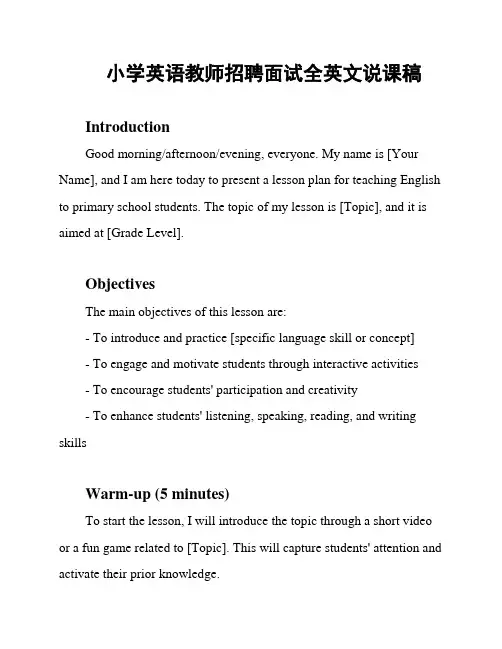
小学英语教师招聘面试全英文说课稿IntroductionGood morning/afternoon/evening, everyone. My name is [Your Name], and I am here today to present a lesson plan for teaching English to primary school students. The topic of my lesson is [Topic], and it is aimed at [Grade Level].ObjectivesThe main objectives of this lesson are:- To introduce and practice [specific language skill or concept]- To engage and motivate students through interactive activities- To encourage students' participation and creativity- To enhance students' listening, speaking, reading, and writing skillsWarm-up (5 minutes)To start the lesson, I will introduce the topic through a short video or a fun game related to [Topic]. This will capture students' attention and activate their prior knowledge.Presentation (10 minutes)During the presentation phase, I will clarify the language target by using real-life examples and visual aids. I will demonstrate and provide clear explanations of [specific language skill or concept]. To make it more engaging, I will also incorporate a short interactive activity where students can practice using the language.Practice (15 minutes)In this phase, students will have the opportunity to practice the language target in pairs or groups. I will design various activities such as role-plays, games, or worksheets that allow students to apply what they have learned. These activities will promote active participation and interaction among students.Production (10 minutes)Conclusion (5 minutes)In the conclusion, I will briefly summarize the main points of the lesson and provide feedback to students. I will also address any questions or concerns they may have.Extension Activities (optional)If time permits, I will suggest additional activities or resources that students can explore outside of the classroom to further enhance their learning.EvaluationTo evaluate students' performance, I will use both formative and summative assessment strategies. Formative assessments will be conducted throughout the lesson to monitor students' progress, while summative assessments can include a short quiz or an observation checklist.Thank you all for your attention. I hope you find this lesson plan suitable for teaching English to primary school students, and I am open to any questions you may have.。
Good morning, dear judges。
It’s my great honor to be here to present my lesson. .I’m number ____,Today I'll talk about the senior English for China student’s book1B unit _____,my content is made up of 8 parts:Analysis of the teaching material,Analysis of the students material ,Teaching aims and important, difficult points ,Teaching aids ,Teaching methods ,Teaching procedure ,and conclusion 。
Well firstly, I’ll talk about part 1, analysis of the teaching material。
This lesson is mainly about ______。
The topic is related to our life,so it's easy to arouse students’ interest。
As we all know,interest is the best teacher for students.Then, I will talk about part 2, analysis of the students. They have learned English for some years, so they can understand some words and simple sentences. They’re active,interested in new things, so I’ll design some interesting actives to attract their attention.Next, I’ll talk about teaching aims。
小学英语面试说课稿模板尊敬的评委老师,大家好。
今天,我有幸在这里进行小学英语课程的说课。
我将从以下几个方面进行介绍:课程主题、教学目标、教学方法、教学过程、以及教学反思。
课程主题:本节课的主题是“我的朋友”,旨在通过学习描述朋友的词汇和句型,提高学生的英语口语表达能力。
教学目标:1. 知识与技能:学生能够掌握描述朋友的常用词汇,如“tall”, “friendly”, “smart”等,并能够运用这些词汇进行简单的自我介绍和朋友介绍。
2. 过程与方法:通过小组合作和角色扮演,学生能够在实际语境中运用所学知识,提高语言运用能力。
3. 情感态度与价值观:培养学生对朋友的欣赏和尊重,以及团队合作精神。
教学方法:1. TPR教学法:通过身体动作帮助学生记忆词汇。
2. 情景教学法:创设真实或模拟的情景,让学生在情景中学习和使用语言。
3. 合作学习:通过小组讨论和合作完成任务,促进学生之间的互动。
教学过程:1. 导入(Lead-in):通过展示不同人物的图片,引导学生讨论他们的朋友,并引入本课的主题。
2. 新课呈现(Presentation):教授描述朋友的词汇,并用TPR教学法帮助学生记忆。
3. 练习(Practice):学生进行小组合作,互相描述对方,并使用所学词汇。
4. 应用(Production):角色扮演,学生扮演不同角色,介绍自己的“朋友”。
5. 总结(Summary):回顾本课所学内容,强调关键词汇和句型。
6. 作业(Homework):让学生写一篇小短文,描述自己的一个朋友。
教学反思:在本节课的教学过程中,我注意到学生对于TPR教学法的反应非常积极,这有助于提高他们的学习兴趣和记忆效果。
然而,我也发现在小组合作时,部分学生参与度不高,这需要我在今后的教学中进一步引导和激励。
最后,我相信通过本节课的学习,学生们不仅能够掌握描述朋友的词汇和句型,更能够在实际交流中更加自信和流利。
谢谢大家。
英语面试说课稿(全英)Teaching Aims:1. To develop Ss’ basic skills of listening, speaking, reading and writing. Reading is the focus in this lesson. Reading skills for Ss include (predicting, skimming, scanning and digesting.)2.To encourage Ss to practice, participate, and co-operate in the classroom activities.3.To get Ss to know something about …and have a better understanding of the importance of …. As for teaching approaches, I think …II Teaching ApproachesCommunicative approach and Computer-Assisted Instruction are to be used in the course of this lesson. And I will try my best to limit TTT, that is, limit Teacher TalkingTime and increase STT (Student Talking Time).So during this lesson, emphases are to be laid on:1. Student-centered teaching2. Task-based learning3. Activity-based teaching (individual work; pair work; group work; class work)III Teaching Aids:1. a projector2. a multi-media puter systemThey are for showing Ss some pictures, some audio files, some visual files, some topics or reading tasks.IV Teaching ProcedureStep 1. Warming-up & lead-inActivity 1 Free talk (class work)I will invite Ss to answer the following Qs.Q1: Who do you think looks coolest in our class?Q2: Do you like him/her?Q3: If so, why? If not, why?…Activity 2 Picture-talking /Music-talking (individual work) Download some pictures/music from the Inter.Guiding Qs may be:Q1: Who’s she/he?Q2: Do you like him/her?Q3: If so, why? If not, why?Q4: Do you think he/she is perfect?…Goal: To lead up to the topic, get Ss to warm up and arouse their interest in thetopic.Step 2. Pre-readingActivity1 Look and guess (class work)In this activity, Ss are required to look at thetitle/subtitle and guess what they will read.Activity2 Brain-storming (class work)In this activity, Ss are encouraged to think of as many words as possible todescribe the picture/…Goal: To develop Ss’ reading skill---predicting and present some new words in thepassage such as …Step 3. ReadingActivity 1 Skimming (class work)Ss are required to go through the whole passage quickly to get the general ideaand pay special attention to the first or last Para of the article (or the first sentence or the last sentence of each Para.)Goal: To develop Ss’ read ing skill --- skimming, that is, how can we get the general idea of a passage as quickly as possible.Activity 2 Scanning (group work)Encourage Ss to read the passage again, exchange their understanding of the passage with their group members and work together to fill in the following form:TitlePart/Para. Main idea Detailed information1 a. topic sentences/introductionb. examples/supporting ideasc. conclusion2a.b.c.Goal: To develop Ss’ reading skill---scanning, that is, how to find out the clue of a story and motivate Ss to cooperate with each other.Activity 3 Report (class work)Invite some group members to report their work to the whole class.Goal: To overe Ss’ shyness and stimulate Ss to speak in public.Activity 4 Further understanding and word study (pair work) Encourage Ss to discuss the following Qs in pairs (A PowerPoint will be used here to present some blank-filling exercises and multiple choices.)Q1: What does the word “this” in the last Para. but 3 refer to?A. sjkdfkjdkB. klklklklC. opieporiwpD. jdlkjflkdQ2: What is the Chinese equivalent for the phrase “investing in loss”?A. B. C. D.Q3: The word “flawless” in Line 5 of Para.2 can be replaced byQ4: Which of the following statements is true or not true?…Goal: To help Ss to guess the meaning of certain unknown words and understand the passage exactly.Step 4. Post-readingActivity1 Role-play(pair work)Suppose one student is a … and the other …. Ss are encouraged to put themselves in the situation and make a face-to-face interview.Activity2 Discussion (Group work)Topics may be :Q1: Do u want to be perfect?Q2: Do u think there is anyone in the world that is perfect? Q3: Look at the subtitle/title “Remind yourself”, remind yourself of what?…Activity3 Poster-designing/Cartoon-designing/…(group work) Goal: These post-reading activities are intended to develop Ss creative thinking and get them to know the importanceof …Step 5. HomeworkTask 1 Write a summary of the passage (about 100 words) (Individual work)Goal: To spur Ss to consolidate what they have learned.Task 2 Look up some more information about … (Individual work)Encourage Ss to go to the school library or get on the Inter if possible toconsult related English websites on the topic.Goal: To encourage Ss to study English spontaneously and independently after class,arouse Ss’。
高中英语面试说课稿高中英语面试说课稿高中英语面试说课稿〔1〕Good morning, ladies and gentlemen. Today I’mvery pleased to have an opportunity to talk about some of my teaching ideas. My representation is made up of six parts:analysis of the teaching material, analysis of the students, teaching methods, teaching procedures, blackboard design and teaching reflection.This is the last part of the unit, It is designedto impove students’ English level through doing a project. In this section, students will read information about two school clubs, and then they will design a poster advertising a new school club. By reading these passages, students will study knowledge of school clubs and improve their reading ability. In the course of writing, students will learn how to plan,prepare,produce and present the new school club. In a word,learing this lesson can improve students'ability of listening, speaking, reading and writing, especially the writing skill.So the selected material plays a very important part in English teaching and learning.Teaching aimsAccording to the new curriculm and syllabus,based on the character of the selected material,I set the teaching aims as follows:Knowledge aim: to get Ss learn some new experssions and know about school clubs. Ability aim: to improve Ss’abili ty of reading and writing Emotional aim: to develop Ss’spirit of co-operation and interest in starting or joining a school clubTeaching important points and difficult points.The teaching important and difficult point in this lesson is how to improve Ss’a bility of reading and writing.1. The Ss have known something about through the Inter and other ways.2. They are lack of vocabulary.3. They don’t often use English to express themselves and municate with others.4. Some Ss are not active in the class because they are afraid of making mistakes.To achieve the teaching aims and deal with the important and difficult points,I’ll use the following methods to conduct my class,they are: Listening and reading;ask and answer petition;discussing and group work.I’ll also use a record and the muti-media to make my class lovely and interesting.With the teaching methods, I can guide Ss to solve problem and plete different tasks.Teaching aids:1. a projector2. a tape recorder3. multimedia4. the blackboardI have designed the following steps to train their ability of listening, speaking, reading and writing, especially reading and writing ability.Step 1 lead-inShow Ss some pictures of a school club, and some Ss' opinions about the joining in a club. Doing so can ari se Ss’interest in this lessonStep 2 Listening and readingPlay the tape for Ss to listen and pay attentionto the pronunciation and intonation,then read the passages to get a main idea. After that ,we’ll have an ask and answer petition about the passages.The activity can train Ss’quick mind,heat the classroom atmosphere.Step 3 Design a poster advertising a new school clubPlanningDivide the class into small groups. Discuss what club they'd like to start.And they've decided the name of their club, then assign tasks to each group member.PreparingGroup members go separately to finish thetasks.Those who are responsible for doing research need to find information about school clubs andposters.The group should discuss the information found and decide what they can learn from it.ProducingGroup members responsible for making the poster need to follow the outline, proofread it and get it approved.PresentingEach group present their poster to the class, explain it.Display the posters and have others vote to choose the best poster.Step 5 HomeworkFinish off the workbook exercises and self-assessment part after classOn the left of the Bb,I’ll write down some language points;In the middle are some suggested answers and some writing skills are on the right side.高中英语面试说课稿〔2〕Good afternoon, teachers, It’s my great pleasure to be here sharing my lesson with you. The content ofmy lesson is Senior English Book unit 1〔A student of African wildlife/Why not carry on the good work〕I’ll be ready to begin this lesson from five parts. Analysis of the teaching material, the teaching methods, the studying methods, the teaching procedure, and Blackboard design. First, let me talk the teaching material. Part 1 Teaching Material:This unit is about〔Great women and their achievements , Important people, history and methods of agriculture, Different types of Englishhumor ,Culture differences and munication Different types of theme park〕By studying of this unit, we’ll enable the students to know some great women and their achievement and what makes the great women successful The knowledge of farming and Dr Yuan Longping’ achievement And chemical farming and organic farming. Charlie Chaplin and his funny and encouraging humor People from different area have different body language and use the right body language to showing our feelings. Theme park not only provide fun but alsoprovide various knowledge and exciting experience.this lesson not only teach the students to learn the related material about (1) the good character to be a successful person (2)Yuan longping’s scientific research spirit and attitudes toward life The disadvantage of using chemical fertilizers and how to increase production in organic farming. (3)Charlie Chaplin and his humor English jokes (4)Different body language and the similarities in body language which make the others understand our feelings. (5)Theme park but also learning ability in English .A: If Ss can learn it well, it will be helpful to make the Ss learn the rest of this unit well. B: It provides all-around practice about listening, speaking, reading and writing revolve around the topic, it isthe expansion of this unit and give Ss a space to use the language So it plays an important part in the English teaching in this unit.〔As we know ,reading belongs to the input during the process of the language learning. The input has great effect on output , such as speaking andwriting . 〕According to the new standard curriculum and the syllabus (新课程标准和教学大纲), afterstudying the teaching material and analyzing the rule of children’s growing of mind, I think the teaching aims are the followings: 1.Knowledge objects: (1)the students can hear, read, and use the main sentence patterns. (2) the students can understand the content of the lesson: (3) the students can use the patternsto express their thoughts in proper situation andlearn how to describe people with adjective. Ability objects: Ability objects of this section are (1)To develop the Ss’ abilities of listening, speaking, reading and writing. Especially speaking and writing ability.(2) To train the Ss’ ability of working in pairs.(4) To improve the Ss’ reading abilities ,especially their skimming and scanning ability. 3.Emotion objects: By reading A Student of African wildlife /why notcarry on the good work, students can learn from(1)Jane Goodall in at least two aspects: one is whatis the human way to study animal; the other is that itwas her great personality-universal love and mercythat made her successful. Lin Qiao zhi in at least two aspects: one is what is the human way to help poor patients; the other is that it was her great personality-universal love and mercy that made her successful. (2)Dr Yuan Long ping his scientific research spirit and attitudes toward life This passage what is chemical and organic farming and their advantage and disadvantage.。
武汉面试英语说课稿模板尊敬的面试官,大家好。
今天,我非常荣幸能够站在这里,向大家展示我的英语说课稿。
我将从教学目标、教学内容、教学方法、教学过程、以及教学反思五个方面进行介绍。
一、教学目标本节课的教学目标是让学生能够掌握以下内容:1. 学习并运用新的英语词汇和短语。
2. 通过听力和口语练习,提高学生的英语听力理解和口语表达能力。
3. 培养学生的跨文化交际意识,理解不同文化背景下的交流方式。
二、教学内容本次课程的教学内容主要包括:1. 新词汇的介绍和练习。
2. 听力材料的分析和讨论。
3. 口语练习,包括角色扮演和情景对话。
三、教学方法为了达到上述教学目标,我将采用以下教学方法:1. 互动式教学,鼓励学生积极参与课堂活动。
2. 使用多媒体教学工具,如PPT、音频和视频,以增强学生的学习兴趣。
3. 通过小组合作学习,培养学生的团队协作能力。
四、教学过程1. 导入阶段:通过一段简短的英语视频,激发学生对本节课主题的兴趣。
2. 新课呈现:介绍新词汇和短语,并通过例句让学生理解其用法。
3. 听力练习:播放听力材料,让学生练习听力理解,并回答相关问题。
4. 口语练习:通过角色扮演和情景对话,让学生实践所学知识。
5. 总结反馈:对本节课的学习内容进行总结,并鼓励学生提出问题和反馈。
五、教学反思在课程结束后,我将进行教学反思,以评估教学效果,并根据学生的反馈进行相应的调整。
这包括:1. 学生对新词汇和短语的掌握情况。
2. 学生在听力和口语练习中的表现。
3. 教学方法和教学工具的有效性。
最后,我相信通过本节课的学习,学生们不仅能够提高英语语言技能,还能够增强跨文化交流的能力。
谢谢大家的聆听,我期待与大家的进一步交流和讨论。
Good morning, ladies and gentlemen! Today I’m going to talk about my teaching design for ... My teaching design is mainly made up of four parts.
Part 1 is about the new curriculum standards of elementary education. According to it, the main object of English teaching is to foster students’ integrated abilities of using language.
The new curriculum standards propose that students should participate in and accomplish some real tasks, and enjoy themselves in learning. According to this, I choose task-based teaching method, to lead the students to learn English cheerfully in an interesting and open linguistic environment.
Part 2 is about the teaching material.
复习巩固课:In this lesson we will review and consolidate what we have learned in the last lesson—“…”
新授课:This lesson we will learn …
So, according to pupils’ foundations of cognition and the content of this lesson, the teaching aims are established as the following 3 aspects:
(1)Aims on knowledge:
(2)Aims on ability:
of listening and speaking; of working in groups; of communication and innovation.
(3)Aims on emotion:
The key points are …
The difficult points are …
Part 3 is about the teaching and learning methods.
English is a linguistic subject, which should focus on listening, speaking, reading and writing. In primary school’s English teaching, listening and speaking are relatively more important. However, understanding and memorizing shouldn’t be neglected. To the pupils, imagery thinking is in the ascendant. They can remember quickly, but they may forget easily. So I choose the following means:
(1)the audio-lingual method 听说法
(2)the explanatory method 讲解法
(3)the practice method 练习法
(4)the discuss method 讨论法
To make this lesson go fluently, I will prepare the mating tape, the relative ppt, and something else.
Part 4 is the teaching procedure, including 5 steps:
Step 1. Warming up and preview.
Free talk; sing a song; guessing games;
Purpose: it is important to form a good English learning surrounding for the students by singing and doing some review, so that they could get new knowledge easily.
Step 2. Presentation. (or Lead-in)
Present the pattern; play a guessing game; with the help of multi-media devices to present the dialogue; mention that we should …(emotion); play the tape, let the students listen and imitate the dialogue. Pay attention to their pronunciation and intonation.
Purpose: the multi-media can provide a real situation for the Ss to understand the dialogue better. Tell them to … (emotion) Encourage Ss to show themselves in front of the class. Develop their self-confidence and the efficient learning strategy.
Step 3. Practice.
Divide the Ss into groups of four children. Everyone would finish the printed form by asking and answering questions.
Purpose: Task-based teaching method is used here to develop Ss’ ability of communication and cooperation. Encourage Ss to participate in the group work actively.
Step 4. Assessment.
Help Ss finish “Let’s check” part of this unit and the workbook.
Purpose: to check the knowledge Ss have learned in this period.
Step 5. Add activity and homework.
Let Ss tell each other …
Homework: (1) to remember new words and phrases, master the sentence structure: …
(2)ask Ss to discuss … and prepare …
Purpose: the revision of the learned knowledge is so important for the Ss that they should practice speaking English as much as they can in class or after class.It is necessary for the Ss to do some extensive exercises after class to consolidate the knowledge they have learned.。